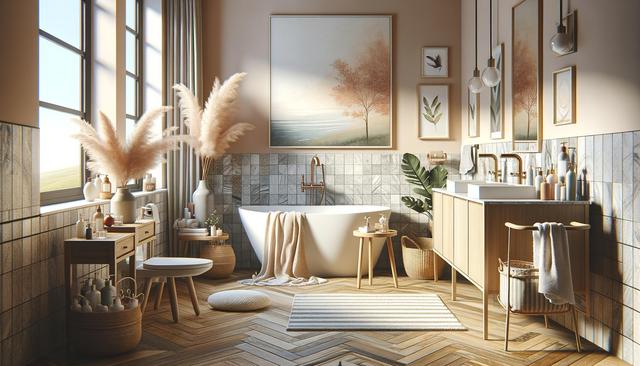Design Tips to Refresh and Personalize Your New Bathroom
Explore design tips for your new bathroom to create a stylish, functional space. From choosing the right tiles to maximizing storage, discover simple yet impactful ideas to transform your bathroom into a relaxing and efficient retreat.

Plan with Purpose: Layout and Function First
Before diving into aesthetics, start with a practical layout. The size and shape of your bathroom will largely dictate the design possibilities, so it’s essential to understand how much room you have to work with. Consider the placement of plumbing fixtures like the toilet, sink, and shower or bathtub. Moving these can be costly, so it’s often more efficient to design around existing plumbing unless a major overhaul is planned.
Factor in how the space will be used. Ask yourself: Is this a guest bathroom, a family space, or your personal retreat? Your answer will influence everything from storage needs to lighting choices. For example:
- Guest bathrooms may benefit from minimal decor and easy-to-maintain surfaces.
- Family bathrooms often require more storage and durable materials.
- Primary bathrooms can focus on relaxation with features like a soaking tub or dual vanities.
Good planning also means considering accessibility and future-proofing. Features like walk-in showers, non-slip flooring, and wider doorways can be beneficial long term, especially in homes where aging in place is a consideration.
Choose a Cohesive Color Scheme
Color sets the tone for any room, and in a bathroom, it can impact how large or small the space feels. Light, neutral tones tend to make smaller bathrooms feel open and airy, while darker shades add drama and sophistication to larger spaces. Whichever direction you choose, consistency is key to achieving a polished look.
Start by selecting a base color for the walls or tiles, then build around it with complementary tones. You might consider:
- White or off-white paired with wood tones for a clean, natural feel.
- Soft blues or greens for a spa-like atmosphere.
- Contrasting black and white for a modern, high-impact aesthetic.
Don’t be afraid to add a pop of color through accessories like towels, rugs, or even a painted vanity. These are easy to swap out if trends or tastes change, allowing flexibility without a complete redesign.
Optimize Storage Without Sacrificing Style
Storage is often one of the most overlooked aspects of bathroom design, yet it plays a crucial role in maintaining a clutter-free environment. The key is to blend functionality with aesthetics. Think beyond the traditional medicine cabinet and consider options such as:
- Floating shelves for a modern look and accessible storage.
- Built-in niches in the shower for storing products without bulky caddies.
- Vanities with deep drawers instead of cabinets for better organization.
For smaller bathrooms, vertical storage is a game-changer. Tall cabinets or ladder-style shelves can make use of wall space without encroaching on the floor area. Also, consider using baskets or containers to keep smaller items organized within drawers or shelves. A well-organized bathroom not only looks better but also functions more efficiently.
Lighting That Works for All Occasions
Lighting in a bathroom must be both functional and flattering. Natural light is ideal, so if your bathroom has a window, make the most of it with sheer curtains or frosted glass for privacy. For artificial lighting, aim for a layered approach:
- Ambient lighting: Typically provided by ceiling fixtures, it gives general illumination.
- Task lighting: Placed around mirrors, it helps with grooming activities like shaving or applying makeup.
- Accent lighting: Used to highlight design features or create a relaxing mood.
When selecting fixtures, consider LED options for energy efficiency and longevity. Adjustable lighting, such as dimmable controls, can also help transition your bathroom from a bright space during the day to a calming retreat in the evening. Pay attention to the color temperature of bulbs—cooler tones are better for task lighting, while warmer tones create a more relaxing ambiance.
Incorporate Personal Touches and Finishing Details
Finally, bring your bathroom to life with thoughtful details that reflect your personality and taste. Décor should be kept minimal due to the typically small footprint of bathrooms, but even a few elements can make a big impact. Consider including:
- Artwork or framed prints that are moisture-resistant.
- Plants that thrive in humid environments, such as ferns or peace lilies.
- Coordinated hardware finishes for faucets, handles, and towel bars.
Textiles also play a role in both comfort and style. Choose high-quality towels, bath mats, and shower curtains that complement your color scheme. Even functional items like soap dispensers and toothbrush holders can be selected with design in mind to maintain a cohesive look. These finishing details help turn a purely functional room into a relaxing and enjoyable space.
Conclusion: Design with Comfort and Practicality in Mind
Designing a new bathroom is an opportunity to blend style with function in one of the most frequently used spaces in your home. By focusing on layout, color, storage, lighting, and personal details, you can create a bathroom that not only meets your daily needs but also provides a sense of calm and comfort. Whether you’re working with a spacious en suite or a compact powder room, thoughtful design choices will ensure your bathroom remains a functional and attractive part of your home for years to come.